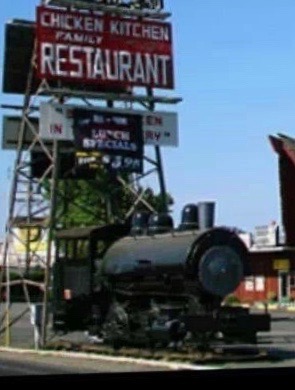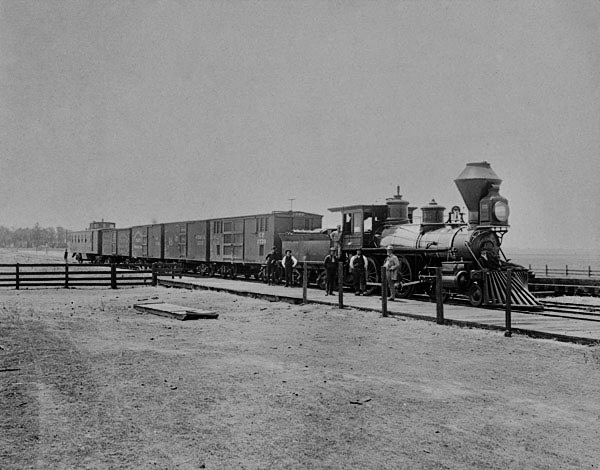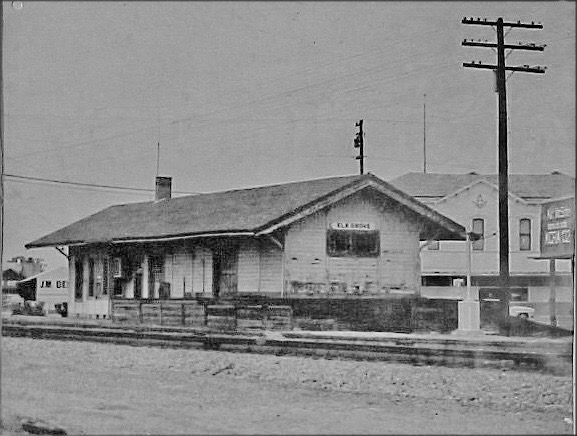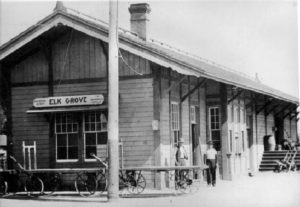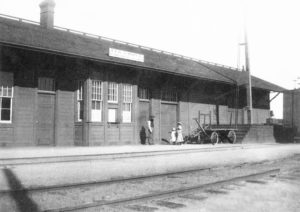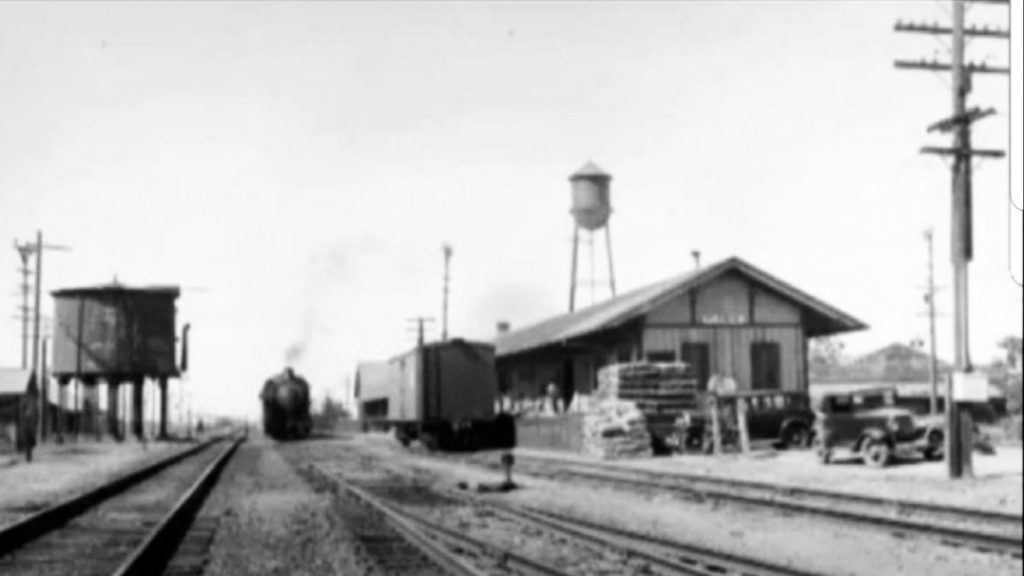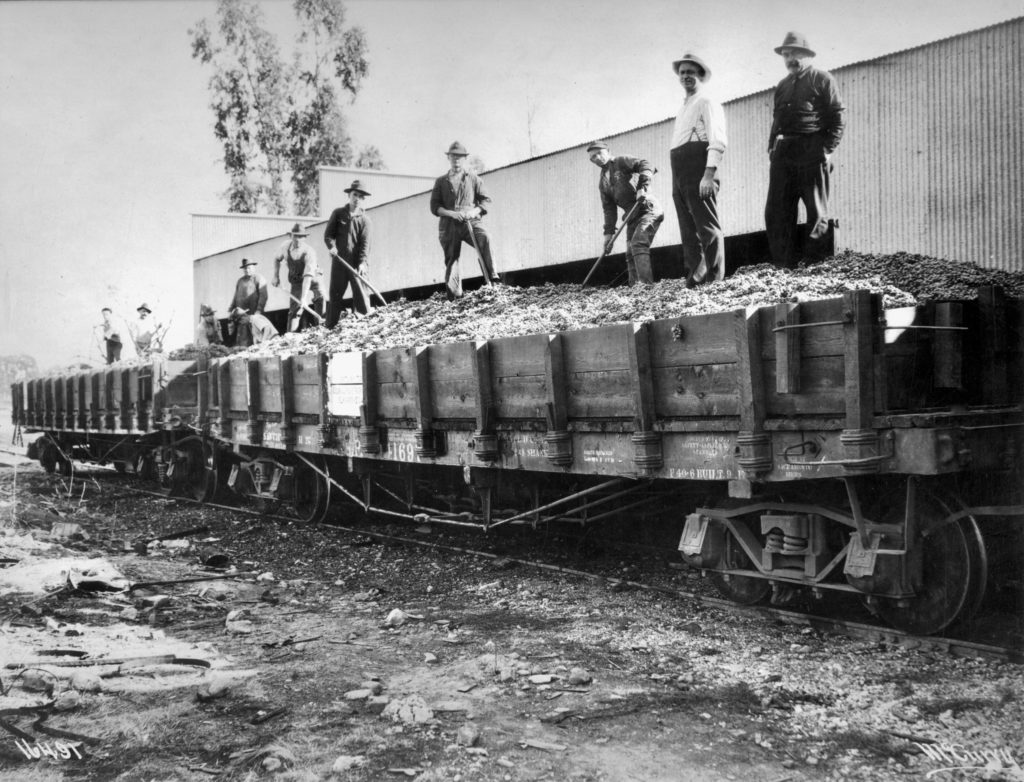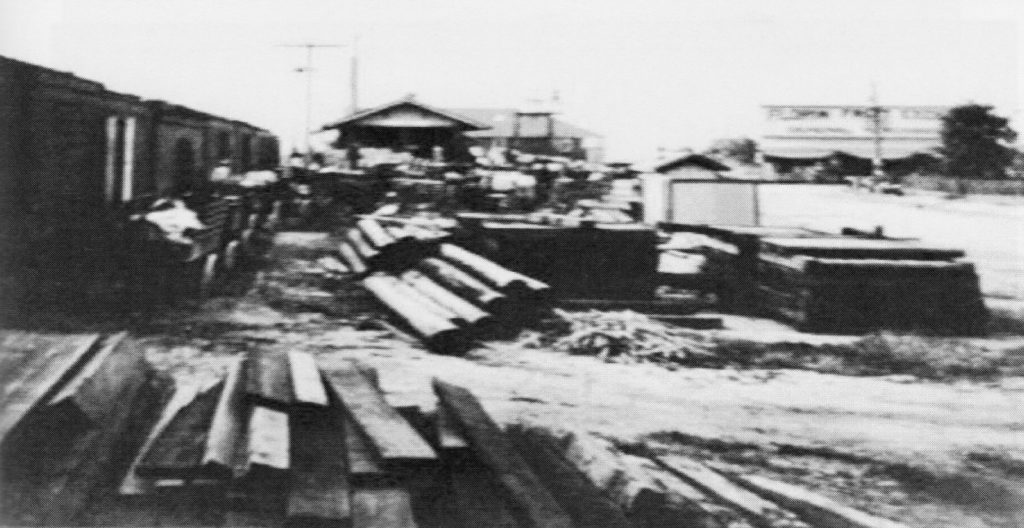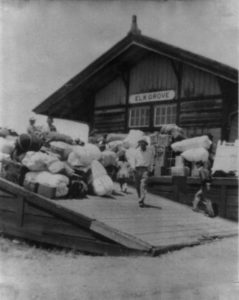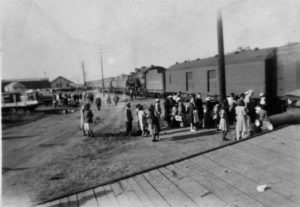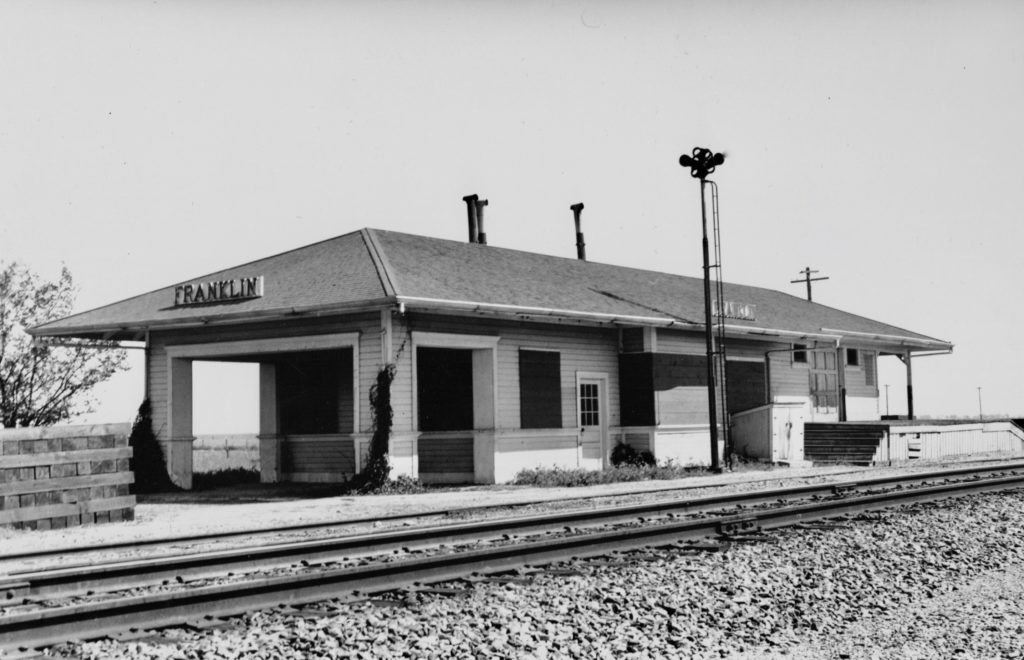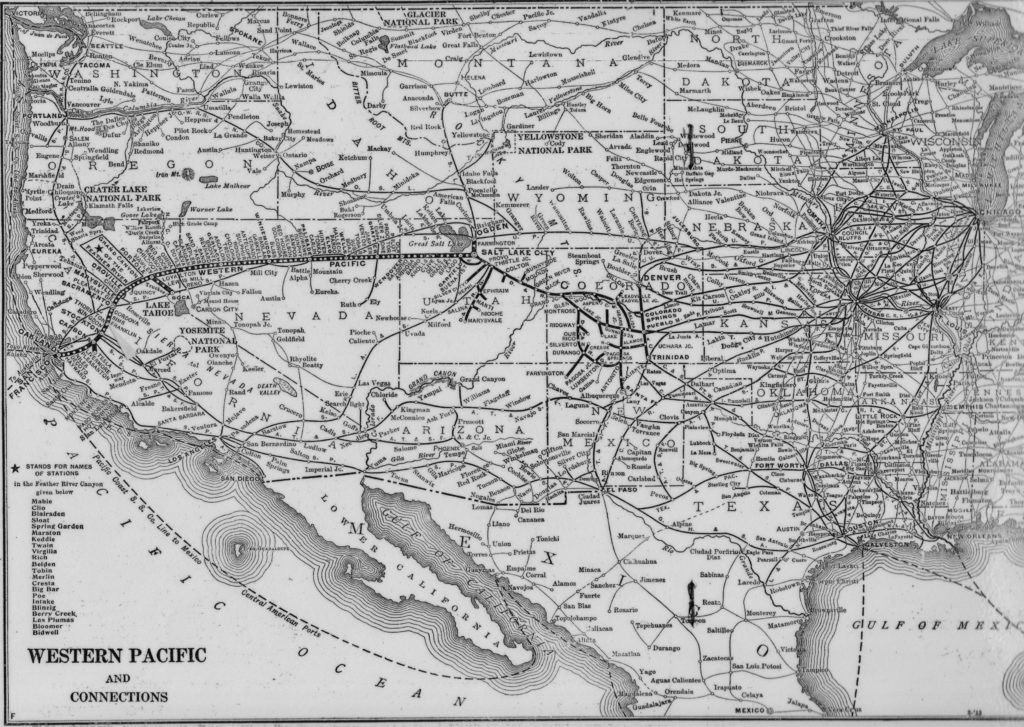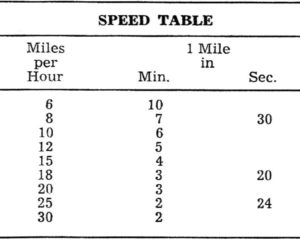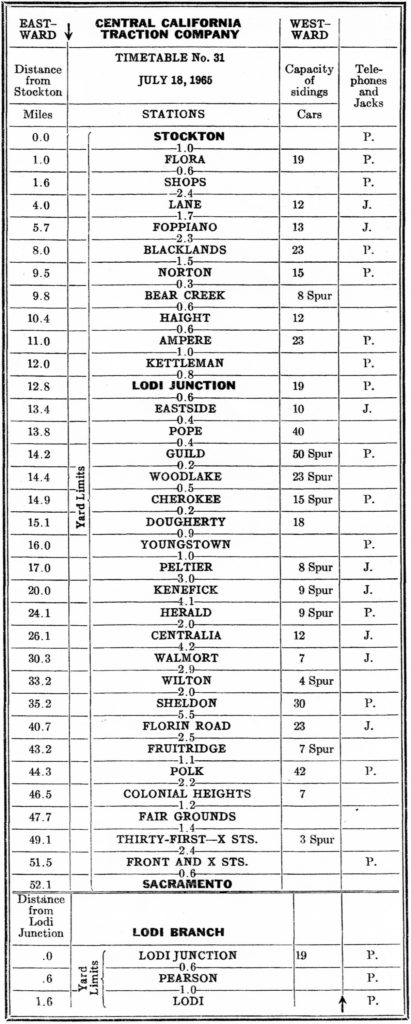In 1850, Elk Grove was just a one building stage stop on the dusty Upper Stockton Road joining Sacramento to Stockton. That all changed eighteen years later in 1868 when the train came through town and the town moved 1 mile east to where the railroad was built. Now the farmers and ranchers had a quicker way to get their produce to market, businesses could receive goods, and residents could travel to their destinations often within an hour. This beat the horse drawn buckboard and wagons that they were using that took hours and days to arrive at their destinations.
In 1910 two more rail lines came to the area; On the western side of town, the Western Pacific line ran through Franklin and Galt and on the east side was the Traction line that went through Sheldon, Wilton, Dillard, Alta Mesa and so on, all connecting our area to Sacramento, Stockton, and to the rest of the world.
Today the Traction line is gone, it had an electrified third rail, but the other two lines are used daily, sometimes hourly, but don’t stop anymore.
Fortunately for us, local historian Elizabeth Pinkerton has done the research and has written about it, along with stories from many who experienced the railroad, in her History Happened Here, book-2, Chapter-7 on the “Railroads.”
She graciously has allowed us to take sections from the chapter to allow us to summarize the history for you. She writes…..
This is the story of our railroad, here in Elk Grove, Florin, Franklin, and later even in Wilton and Sheldon. It’s the story of how the railroad changed the lives of everyone who lived around those long stretching tracks of steel. It’s the story of trains and traveling on trains, listening to those mournful whistles and being awed by monstrous steam belching locomotives. You can experience it somewhat when you visit our marvelous Railroad Museum in Old Sacramento, but this is the story of when it was real – right here in our own backyards.
Across our south Sacramento County region, we had three railroad lines, and although two of them still carry freight, there are no depots, there is no passenger service, and the trains do not stop any more. They blow their whistles at the crossings, and we wait until they pass by before we can continue our travels. We hear them at night, a nuisance for some, but for others it is a reassurance that all is right with the world because the train is there and it’s our connection to the world outside of backyards.
Only those who have been around for some time know the spots where the railroad stations once stood. Both Florin and Elk Grove had real railroad depots, and so did Franklin. Trains stopped at Sheldon, Dillard, McConnell’s Station, Herald, Arno and just about anywhere else there was a need to pick up passengers or freight. When the three railroad lines of yester-year were operating, it was a far different story for our residents than it is today. Folks could take the train to Sacramento, spend the day and return home in the evening. They could go to Stockton or practically any other city or town in California, and they could make rail connections from Sacramento to places across the nation.
When families came to Elk Grove on the train, they could rent a horse and buggy right next door to the depot and go to Elk Grove Park or wherever they had to go to visit or take care of business. Who knows – maybe one day we will be able to do the same with our own little trolley system or something modern that would get us where we wanted to go.
The railroad story began for us in 1868, and it ended in 1972 when the station in Elk Grove closed. That first line was the Western Division of the Central Pacific Railroad, later purchased by the Southern Pacific. Those are the railroad tracks that go through downtown Elk Grove today, but it is now the Union Pacific, and you will see Santa Fe cars traveling on it too.Elk Grove’s Railroad Depot was on the east side of the tracks, on the south side of Main Street which is today’s Elk Grove Boulevard. Little Railroad Street in Old Town is the lasting reminder of Elk Grove’s railroad days – and the long lines of cars stopped on the street as they wait for the train to go through.
The second line through our south Sacramento area was the Western Pacific Railroad in 1906. Those tracks still run through West Elk Grove (Laguna) and Franklin. The third railroad in our area was the Central California Traction Line in 1911, the line that ran through Wilton and Sheldon. The Traction Line was a most extraordinary railroad because its power was a third rail that was electric! The Traction Line ceased all operation in 1998.
1868 – The Railroad in Elk Grove
The year that we entered railroad history was 1868. We in Elk Grove had the second rail line out of Sacramento. It connected us to Stockton and the rest of the world. The first tracks were those of the Sacramento Valley Railroad that went from Sacramento to Folsom. It is not surprising that Folsom and Stockton were the first destinations for travelers out of Sacramento because that is where the action was during the gold days.
What is strange to some of us is that the new railroad tracks missed our infant town of Elk Grove. Our little struggling town was out there on the highway on Upper Stockton Road, but the railroad missed it by a little more than a mile. The tracks also missed the town of Sheldon that had been a thriving wagon making place in the earlier days of gold. Sheldon later got its railroad with the Traction Line, but Elk Grove had to move itself over to the new railroad tracks. Today, we have only the cemetery to mark the spot where the first town of Elk Grove was – at the intersection of today’s Highway 99 and Elk Grove Boulevard.
Railroad history in California gets a bit complicated, but thanks to our railroad expert, William Lugg, here is how we happened to get those railroad tracks in this part of California. The Central Pacific Rail Road was incorporated on June 28, 1861. It was consolidated with the Western Pacific Railroad the next year and with the San Francisco Bay Rail Road in 1870 as a new corporation called the Central Pacific Railroad Company. The CPRR went through numerous consolidations and re-incorporations until it was merged with the Southern Pacific Company in 1959. The Central Pacific built and owned the trackage south of Sacramento through Stockton and on to the Bay Area through Niles Canyon. The Southern Pacific Railroad Company was formed in 1865 and built mostly south from San Francisco into southern California and eastward from there.
The first Central Pacific train went through on the Sacramento-Stockton line in 1868. If our Elk Grove folks found themselves left alongside the road, they soon realized what they would have to do. It took our founding fathers eight long years, but by 1876, the town of Elk Grove began its march to the east. That’s the beginning of what we know of today as Old Town, the business area on both sides of the railroad tracks.
The trains could pick up and deliver mail
The Elk Grove Depot station was a wooden structure of the same style architecture as many depots across the United States. Its distinctive look made it a landmark in downtown Elk Grove. The last depot was on the east side of the tracks – a spot that old timers of the area remember very well. There was a previous depot on the west side of the tracks, but it burned down in the disastrous 1892 fire that destroyed most of Elk Grove. When it was rebuilt in 1893, it was placed on the other side of the tracks.
There are many facets to the railroad story of south Sacramento County. Rail travel dramatically cut down the amount of time it had taken to go to Sacramento and back with a horse and buggy. Mail delivery and pick up was by train, and the daily newspaper could be dropped at your ranch if you were close to the tracks. People came to dances in Wilton, Elk Grove and Franklin where they danced all night and went back home on the next day’s train. The Bradford family of Bruceville and the Valensins of Hicksville threw marvelous parties that were attended by carloads of guests that came by train. The Bradfords even had their own private spur from the Franklin tracks to their Bruceville ranch.
Picnickers came to what is now Elk Grove Park for the annual Grange Picnic by train which is one of the reasons why so many families were able to attend. The livery stable next to the tracks in downtown Elk Grove was busy all day shuttling people back and forth to the Park. Salesmen called “drummers” (because they were always drumming up business?) traveled on the trains and attempted to sell their goods to passengers. They created a new definition of traveling salesmen.
As rail services gradually declined, the first to go was passenger service. After that it was just a matter of time before all our depots were closed. In the late 1970s Elk Grove’s landmark railroad depot building was taken apart and moved to an unknown location in southern California. An unsuccessful community attempt was made to save the building, but this was not a time when preservation of historic buildings was high in the public mind.
1868 – The Railroad in Florin
At the same time, Florin was also a stop on the Central Pacific Line. This is how the name of Florin originated, named by Judge E. B. Crocker when the new railroad line was surveyed. The Judge was impressed with the multitude of wild flowers in the region, and thus the Spanish name of flor that resulted in Florin as we know it today.

Visualize the entire area from Highway 99 east to Bradshaw Road, south to at least Gerber Road, and north to Elder Creek. That is what was once known as Florin with its center at the place where the railroad crosses Florin Road. A reminder of the town that once was is still there, and you can find it on the road that winds down alongside the railroad track. Follow the road and you will find Frasinetti’s Winery and Restaurant, a wonderful place to experience the history of Florin and its relationship with the railroad.
Florin Depot 1930 looking north, Frasinetti’s Winery is to the left
The railroad station was established in 1875; Johnson & Sugden have been heavy dealers in fruit. In 1876 they handled over 500 tons – 75 tons of strawberries, over 200 tons of grapes, and the remainder being peaches, apples, etc. In 1877, they shipped about the same amount. In 1878, they shipped 500 tons of grapes alone.
A load of grapes ready for market
Grapes and strawberries are what made Florin famous, but it could not have happened without the railroad. Try to imagine strawberry fields and vineyards all the way from Highway 99 to Mather Air Force Base. That was Florin when it was known as the Strawberry Capital of the nation! One year 240 carloads of Strawberries were shipped out of Florin.
Trains being loaded from wagons at the Florin depot
You can see that agriculture flourished in south Sacramento County after the coming of the railroad. By 1900 Florin was the largest shipper of fresh strawberries in the nation. Hundreds of carloads of Tokay grapes were also shipped from there. It has been said that it only took two carloads to pay the grower’s expenses. As many as 100 carloads were shipped in a season. If you do the math, you will see why the railroad made such an impact on our agriculture and why we were blessed to have three major railroad lines run through our rural areas. The trains had a significant impact upon agriculture, especially the raising of fruit crops that needed to get to their markets fast. As a result of the railroads, life became quite different for everyone in the little towns and crossroads of south Sacramento County.
Packing shed on the northeast corner of Florin Road
Sadly, for the town of Florin it all ended around 1942. The Japanese farmed all the strawberries and grapes on their land and when the internment was handed down 2000 Japanese were taken away in a months time and there was no one to continue producing and harvesting the crops. Most didn’t come back in 1945 when they were released because they had lost everything. The town was never the same after that.
1910 – The Railroad in Franklin
The second line to come through our area was that of the Western Pacific, but not until 1910. The Western Pacific Railway was incorporated in 1903 and construction began in 1905. The first spike was driven at the west end of construction in Oakland, California on January 2, 1906. There may have been some freight movements on the line before the first through passenger train traversed the rails but they would have had to occur after the issuance of the timetable in January 1910.
A Shuttle Car for passengers from Elk Grove to Sacramento
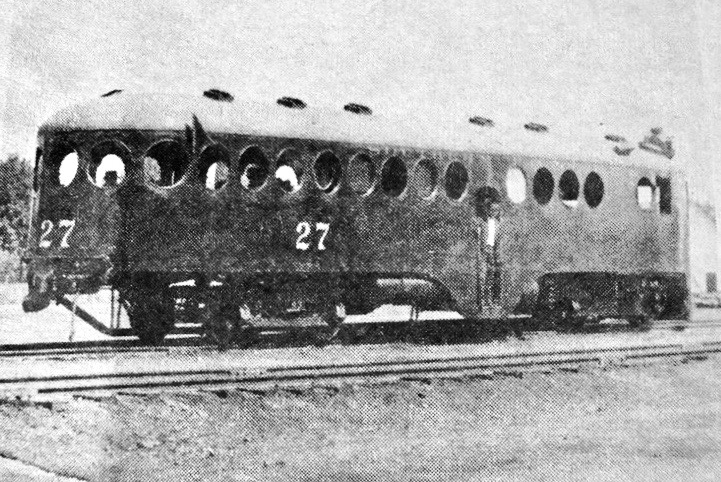
The Western Pacific tracks run parallel with Franklin Boulevard to the Mokelumne River after crossing the road just south of Elk Grove Boulevard. With the coming of the railroad Franklin joined Elk Grove and Florin as busy shipping centers of fruit throughout the summer and fall seasons.
The late Henry Kloss, a lifelong resident of Franklin, fondly remembered the big trains that passed through little Franklin. Henry took his first ride when he was a young boy, traveling alone from Franklin to Stockton where his grandparents met him with their horse and buggy. Henry wrote…
“Franklin’s railroad depot was on Bilby Road, east of the tracks and south of Bilby. There were both a long siding and a short siding. That station was also a wooden structure, and it too succumbed to fire, but not until the 1950s. The trains came through Franklin twice a day – one was northbound the other southbound.”
As a schoolboy, Henry Kloss gathered armfuls of brilliant poppies that grew so splendidly along the tracks. It was a fine springtime entrepreneurship for he sold the flowers to passengers for five cents a bunch. For a young lad of the 1920s, this was a goodly sum indeed.
Franklin became quite a stop on the Western Pacific line. The train could take you to Stockton or Sacramento, and even such diverse visitors as the circus and piano tuner came to Franklin on the train.
The railroad tracks still run through the Buscher ranch on Franklin Boulevard where Agnes and Henry Buscher had their home for so many years. Their son Dennis lives in the beautiful old Victorian he restored – the Kunsting home that he moved from Franklin Boulevard to his place. Just a stone’s throw away on the other side of the Buscher ranch, Dennis listens to the trains every day as they rush through Franklin. Dennis shares…
“I have been searching for years for a photo of the Franklin Western Pacific Railroad depot and found one from 1940. The windows were already boarded up, and a few years later the station burned to the ground. It was still in use in June 1939 as evidenced by the Western Pacific Time Table showing the stops from San Francisco to Salt Lake City.”
Galt was part of that system:
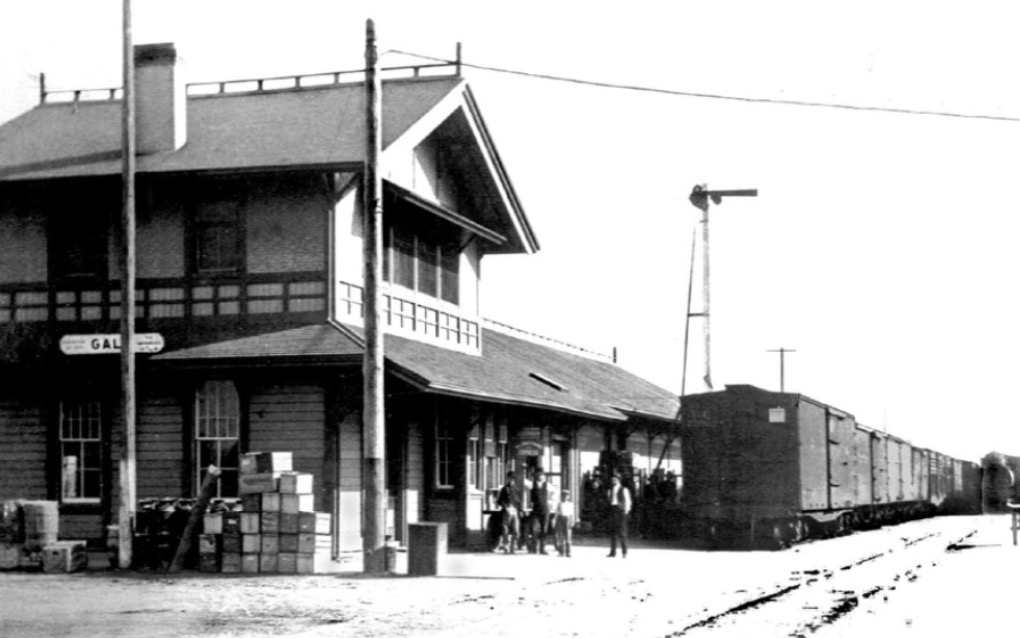
1920 – The Railroad in Sheldon and Wilton
Traction Company Motor Car #205 on Sacramento-Stockton run
(Photo was taken in 1923 on 8th Street in Sacramento)
Old timers who grew up in the rural areas of Sheldon and Wilton always spoke fondly of the Central California Traction Line. This railroad entered their lives in 1910 and became their window to the world. The Traction Line was an amazing electric railroad that ran the 48 miles from Stockton to Sacramento. As you can imagine, it opened up a vast region to agriculture and contributed to the settlement of south Sacramento County. The freight service carried merchandise, livestock and produce, primarily grapes and strawberries.
A Grant Line resident remembered the opening of the Central California Traction Line with much thankfulness for the way in which life was enhanced by modern transportation: “We had stations in Sheldon and Wilton. When we could ship there, we would haul those cans of cream there and leave them to be picked up. The little train came along and took them to Stockton. In the 1920s there was a regular real estate boom in Wilton after the coming of the Traction Line. It was just so wonderful to have that train. We would go into Sacramento and shop all day and come home at night. It only took one hour to get there. It was wonderful!”
The Traction Line also opened up a new source of danger for the parents who lived near that electric line. Long time residents of the area who were children in those years remembered well the stern warnings of their parents to stay away from the dangerous tracks. That third rail carried electricity, and electricity was something new in their lives. Dared by schoolmates and pals though, or sometimes just curious to see if they could do it, they jumped across that wood-covered rail. Their parents, of course, usually did not know of their dangerous game, and it is probably well that they didn’t. To our knowledge, none hit the rail, for if they had they would have been electrocuted on the spot!
Originally the Central California Traction Company planned to run a line southward from Sacramento through rural farms and grape vineyards all the way to Modesto. It was anticipated that most of the San Joaquin and Sacramento County communities would be connected to the main tracks by branch lines. The first purchases in 1905 were for electric cars, car motors, air brake equipment and track materials. Streetcar lines in Stockton opened in May 1907, and a gold spike ceremony was held on August 31 in front of the Lodi Hotel. In 1910 the railroad was completed to its terminus in Sacramento. The cost was nearly a million dollars.
Overhead wires were used in Stockton, Lodi and Sacramento as the power source for the electric train. In the rural areas, power was transmitted by a wood-covered third rail, energized at 1200 volts DC. The Central California Traction railroad was one of the first in the United States and the first in California to use high tension direct current. Previous voltage had been 600 volts or less. By 1914 the electric line operated 36 daily passenger trains. Can you imagine that many trains running through Sheldon?
The first cars were painted red, but later Pullman green became the popular color, and in the 1930s, yellow emerged as the official color. The wooden cars were attractive and equipped with both trolley poles and third rail shoes so they could run in the cities as well as the country.
The doom of the electric train and its passenger service though was signaled by ever-increasing popularity of the automobile and subsequent highway improvement. People just quit riding the train when they could get to their destination with a fancy new car, and they could follow their own timeline instead of having to go by the train schedule.
The Central California Traction Company finally gave up the battle after years of declining revenues. The last interurban passenger run was made on February 4, 1933. The original owners, the Fleishackers of San Francisco, tried to sell the California Traction Line to the Southern Pacific. This resulted in a power struggle among Southern Pacific, Western Pacific and the Santa Fe Railroad with all three vying for control. A 1936 decision allowed joint operation of the Central California Traction by all three railroads.
Electric power costs to maintain freight service proved too costly, so in 1947 the Central California Traction railroad lost its uniqueness and trolley power was abandoned.
Below is a Central California Traction Company Timetable from 1965:
(FYI – I can’t explain this timetable and another we have from 1973 when the line was supposed to be shut down by 1947? Maybe the electrical part was shut down, but was still used as a rail line?)
The following description of the Traction Line is from an issue of RAILFAN RAILROAD:
North of Lodi, it is relatively easy to follow the Traction Company. To the south the roads seem to cross the tracks, but north of Acampo Road it’s possible to follow the train on paralleling Kennefict Road for several miles before having to go around while the Local negotiates the Dry Creek Bridge. Between Simmerhorn Road and Herald, the tracks are followed by Herald Road up to the SP Ione Branch crossing. State Highway 104, which follows the SP east, is not protected by automatic gates or lights, so the Local pulls up to the highway and brakeman will look both ways to see what the highway traffic is like before signaling the engineer to proceed. Once the way is reasonably clear, fuses are thrown into the roadway, the beautiful Nathan M5 air horns blare, and the Local is on its way again.
Laguna Creek has another speed restriction for the trestle, and the Local will crawl across while anyone following can swing around to the far side via Alta Mesa Road to Colony Road. Although Colony Road is somewhat removed from the railroad, it is possible to follow the line rather closely and pick up the train at various locations. The further north the train runs, the less intensive is the agriculture. By the time the railroad gets north of Herald the scene is mostly pasture land with a few outlying clusters of homes, obviously chose by those who are attempting to escape the confines of the nearby cities.
As the Local nears Wilton, the afternoon will have worn well along, but the crew will likely be very much awake at this point. The 60 clobbered an empty sand truck at unprotected Green Road crossing a few months ago, and the resulting damage rendered the unit’s front steps into a ball of twisted metal and punched a couple of holes in the battery boxes on the engineer’s side. Fortunately, the only significant damage was to the truck and the Geep’s steps and not the crew or the truck driver. It seems unbelievable that the driver missed the oncoming red and white Geep with its electronic strobe flasher and blaring airhorns. For now, the crew is even more alert when approaching this particular crossing since the gravel pit just to the east assures a stream of trucks.
Just past Wilton, the train will slow for the most interesting and scenic part of the run. The Traction Company crosses the Cosumnes River and its high water bypass on a pair of long, low trestles, with Wilton Road paralleling within feet of the track. The train steps gingerly out onto the frail-looking structures with the engineer periodically peering down the 30 some feet to the ground below. Right in the middle of the main span is a mild curve to the north which can provide excellent photographic results both north and southbound. As the train comes off the trestle, it must negotiate a small rise to get out of the river valley and up to Sheldon. By the time that the Local bellows up to Grant Line Road, which bisects Sheldon, the train will be making up speed for the last leg to Fruitridge. One interesting note on Sheldon is the last wood-sheathed boxcar on the railroad, CCT 3051, an ex-WP 17000-series car which is used for storage of maintenance materials and tools.
North of Sheldon, the railroad makes a beeline across the countryside through an increasingly urban setting. Traffic on the interesting highways begins to take on a more bustling flavor as the train nears Sacramento, with evening commuters becoming the rule rather than the exception. The last couple of miles into Fruitridge exhibit a sharp contrast from the fields to the industrial developments which provide so much of the CCT’s income.
Upon arrival at Fruitridge, the Local will leave its cars on whatever track is available. Usually, the Fruitridge Switcher will have the Menking track clear, but occasionally, and often during the fall rush, the Local must stash its cars away onto several tracks. Once the train is in the clear, the Geep will be backed across Florin-Perkins Road and either left on the main or placed in the 80s slot to allow the crew to go to beans. While the Local’s crew is at chow, RS1 80 will grab all of the WP cars and head for Haggin Yard on the northwest side of Sacramento. Once the Switcher returns, the Local will make up its train and head for home. During the long summer months, the Local will be departing town just as the twilight begins to engulf the setting sun.

Photos shared by the Elk Grove Historical Society (Dennis Buscher, Jim Entrican, Louis Silveira) and the Florin Historical society (Curt Darling).
If anyone is interested in reading more detail and oral stories by local residents about the railroad, please contact Elizabeth Pinkerton for her History Happened Here: Fields, Farms, and Schools, Book-2 at (916) 685-0606 or elizabethpink@ gmail.com.
If anyone is interested in reading about Mary Tsukamoto’s amazing and detailed story of her families Japanese internment in 1942-1945 please contact Elizabeth Pinkerton for her We The People – A Story of Internment in America at (916) 685-0606 or elizabethpink@gmail.com.
Again, Thank you Elizabeth Pinkerton for the in-depth research, dedication, and history of the rail system in our area and sharing it with us.

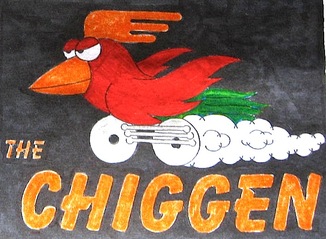
FYI – Check out “Pollardville” in the MENU (History – Other Related Topics) to discover the story of the “Chiggen” which was part of the billboard of the fried chicken restaurant in Stockton for 30 years from 1967 to 2006.
